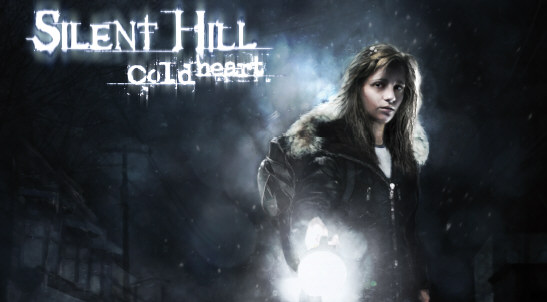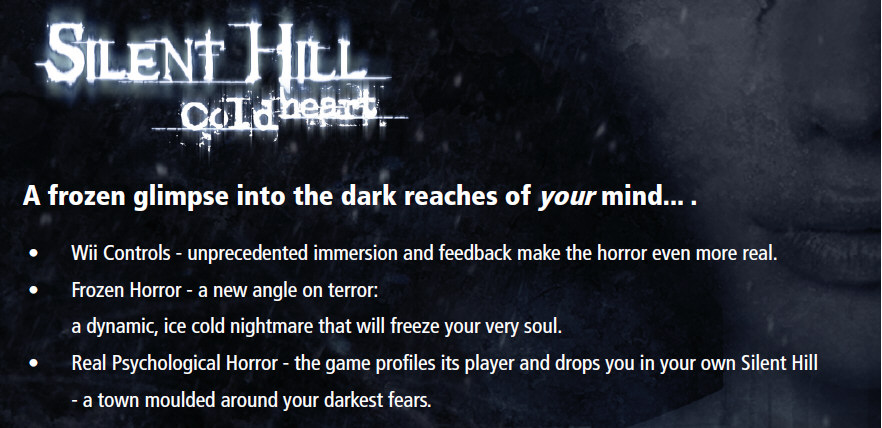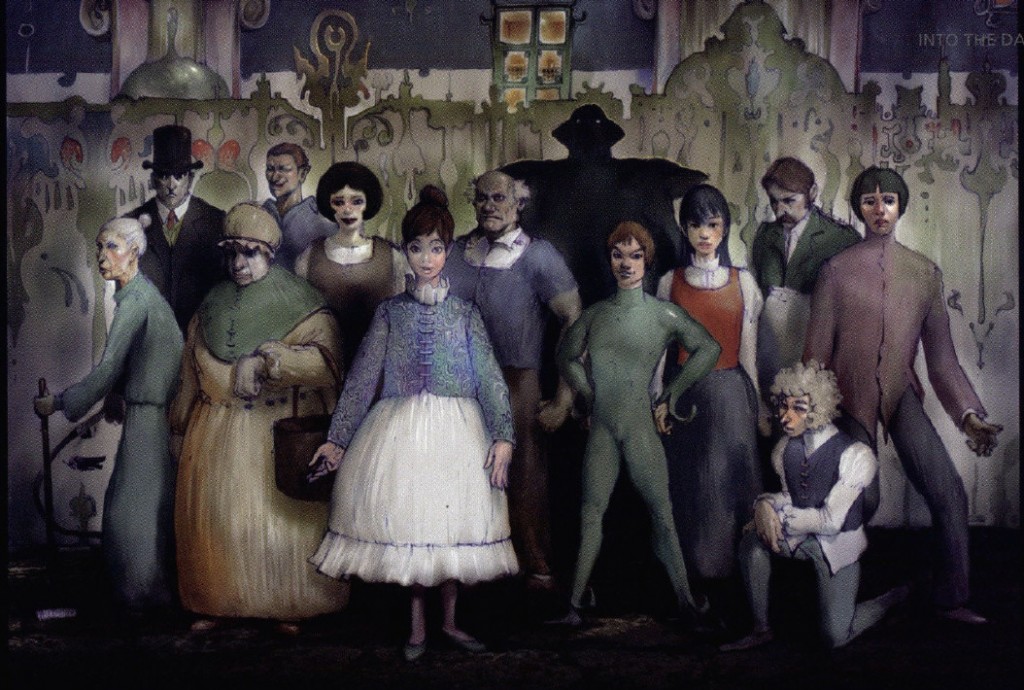Silent Hill: Cold Heart was a pitch for a new Silent Hill game that eventually became Silent Hill: Shattered Memories. This pitch came to light when the developers Climax Studios held a competition to give away eight copies of the document to fans, who since have uploaded it to the Internet so that other fans can enjoy it. Cold Heart was planned in 2007 by Climax for the Wii and would have been published by Konami.
Cold Heart would have followed Jessica Chambers an athletic but emotionally vulnerable college student. The protagonist would have recently being talking to a psychiatrist after being plagued by horrific nightmares and being unable to sleep. These distressing circumstances lead to Jessica leaving her college town and going on a road trip to go back to visit her parents, on the way back Jessica becomes caught in a blizzard and so follows an ambulance that leads her to the town of Silent Hill. This is where the game would begin with Jessica stranded and needing somewhere to stay the evening: she explores the town, but now her nightmares start to become real.
The game would contain the usual elements of a Silent Hill game but would use features of the Wii such as the Wiimote to control where the player shines the flashlight. The Wiimote was to be used for a large number of controls in the game, in combat the player would swing the remote to enact the actions on the screen, it is also noted that the sound of hitting an enemy would play through the speaker on the remote. The remote would also be used for when puzzles needed to be solved, using push, pull and turning motions. Also for puzzles certain audio cues would be played through the remote that would hint on how to solve them. The remote was also going to be used for interactions with other characters, allowing you to point, nod or shake your head.
The “world’s first real psychological horror” is how Silent Hill: Cold Heart is described in the pitch, this is because of the ways in which the game would tailor itself to the individual, creating unique experiences for different players. These experiences that would change would be story events, dialogue, sound cues, monsters and even camera field of view. Profiling was one of the ways this would be done when certain questions were asked by Jessica’s psychiatrist, the players answer would be logged, also your response to events would also be tracked, thus building up a psychological profile for the player. Climax also wanted each player’s psych profile to be shared and compared to friends over Nintendo Wi-Fi Connection.
Climax also wanted to change the way that the player can use their inventory, rather than being able to collect many items, it would be restricted to what could only be worn or stored on the body of Jessica, or in a small backpack the player could use. This was because Climax wanted to have survival type elements to the game, with the player having to find new clothes to protect themselves from the blizzard that would rage through Silent Hill. The player would also have to eat food and drink water to maintain their health. These items would not just maintain the health of the player though, it would also maintain their body heat and stamina.
There are a few puzzle examples also noted in the pitch document, such as the metal detector, the player would have to slowly move the Wiimote and use the audio cues of beeps from the remote to find hidden objects in the snow. “Sewer Fishing” is also another puzzle noted, this is where the player would have to try and collect a key while using rumble and audio cues to fish it out.
The main technical features that are mentioned in the document are that the game would have dynamic weather, mentioned are updated fog effects from Silent Hill: Origins, these would allow the fog to react to the different shapes of the environment. The variables of the weather would also change so that the player would have different intensity of the blizzard.
Climax also wanted the game to be seamless, to do this they were going to “stream” content ahead of the player by anticipating where the player would guide Jessica, this would mean that there would be little to no loading times in the game. They also wanted to push photo-realistic graphics on the Wii and were confident that they could “redefine” what people could expect from real-time graphics on the WII.
One other feature that was mentioned, pending talks with Nintendo, was the integration of players Mii, their local weather and news. Climax wanted to be able to quote this in the game so that it would “spook” the player. With the Mii integration they wanted to use certain aspects of the user created Mii such as hair colour and project them on to the main characters in the game.
Contained in the document is a large description of some exploration, combat and puzzle solving, if you would like to read through this to see some of the experiences you would have in the game, please download and read the pitch to get a detailed understanding.
Ultimately, Cold Heart was never realized but a few details were used in Silent Hills: Shattered Memories as the cold and harsh environment, the use of a psychological profile to change some situations and parts of the plot. This pitch is however a really interesting look into how a different version of one of the top rated survival horror games could have looked like. Shattered memories was released for Wii in 2008 which was essentially a reimagining of the very first Silent Hill game, and it reviewed fairly well, it does however leave questions of how well a different story and character would have done.
If you have any more information on this game or any questions, please don’t hesitate to leave a comment below.
Videos:




![Dino Crisis [GameBoy Color – Cancelled] Dino Crisis [GameBoy Color – Cancelled]](https://www.unseen64.net/wp-content/uploads/2015/03/dino-crisis-gameboy-color-cancelled1-670x300.jpg)